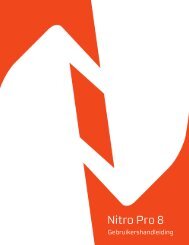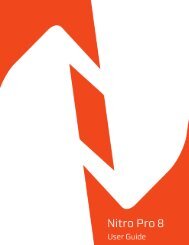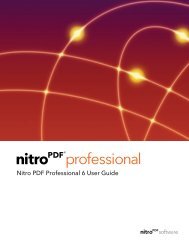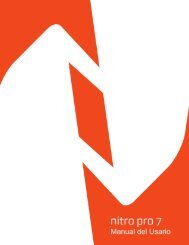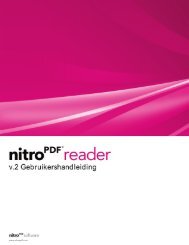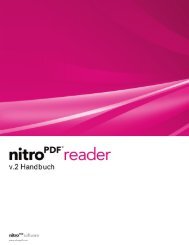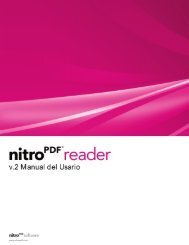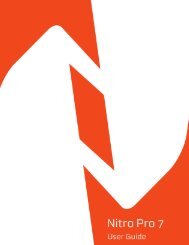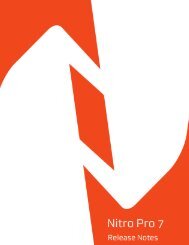Nitro PDF Professional User Guide
Nitro PDF Professional User Guide
Nitro PDF Professional User Guide
You also want an ePaper? Increase the reach of your titles
YUMPU automatically turns print PDFs into web optimized ePapers that Google loves.
12. Forms<br />
© 2008 <strong>Nitro</strong> <strong>PDF</strong> Software<br />
Digital signatures 69<br />
commenting, form filling and signing). If any change is made to the document after certification, its<br />
certificate becomes invalid.<br />
· Only allow form fill-in actions. Disables all tools that can be used to change a file, except for the<br />
form filling and signing tools. An example of when you would use this is when collecting information<br />
from users via an official form that requires the user to enter their information but must not allow<br />
them to change the form you have designed.<br />
· Only allow commenting and form fill-in actions. Disables all tools that can be used to change a<br />
file, except for the form filling, signing, and commenting tools. An example of when you would use<br />
this is when reviewing a contract that may require signatures and comments during the reviewing<br />
stage.<br />
Why certify a document?<br />
· When you want people to be able to sign, form fill or annotate a <strong>PDF</strong> file without invalidating the<br />
certificate.<br />
· To attest you are the document’s author.<br />
· To vouch for its contents.<br />
· To specify what changes are permitted for it to stay certified.<br />
· To automatically disallow functionality such as inserting pages, changing text, and editing form field<br />
properties.<br />
Tip: <strong>PDF</strong> files can be certified only once, but if permissions allow, can be digitally signed many<br />
times. This is the benefit of certifying the files you author rather than just signing it.<br />
To certify a <strong>PDF</strong> document:<br />
1. On the Secure and Sign ribbon, in the Signatures group, click Certify .<br />
2. On the Certify Document dialog, choose the actions you want to permit from the Permitted<br />
actions list.<br />
3. Click Next.<br />
4. Select the digital ID with which to certify and choose whether to make the certificate visible or not.<br />
5. Click Next.<br />
6. If you chose to make the certificate visible, click on the page where you would like it to appear.<br />
7. On the Certify Document dialog, do the following:<br />
· Choose a reason for signing the file from the Reason for signing document list, or enter your own<br />
reason.<br />
· Choose to save the certification to the current document or save as a new document.<br />
· Choose how you would like the certificate should appear.<br />
8. Click Finish.<br />
Note: When sharing certified <strong>PDF</strong> files with other users, the <strong>PDF</strong> viewer they use must support<br />
the functionality for certification and signatures to work correctly. <strong>Nitro</strong> Pro, Adobe Acrobat and<br />
Adobe Reader can all share certified and signed <strong>PDF</strong> files between them.<br />
Forms are one of the most common uses of <strong>PDF</strong> documents. Using form tools and JavaScript you can create<br />
dynamic, interactive documents, and create alternatives for writing complex HTML code when hosting forms<br />
on web sites. There are seven form tools in <strong>Nitro</strong> <strong>PDF</strong> <strong>Professional</strong> used for creating <strong>PDF</strong> forms. Each tool<br />
offers a number of different settings to control form behavior and appearance.<br />
When a <strong>PDF</strong> form is opened in <strong>Nitro</strong> Pro, the Information bar (above the document pane area) appears,<br />
notifying the user that the file contains forms fields.



